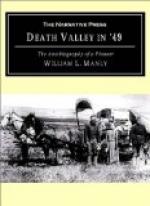It was a remarkable clear and rapid stream and was now low enough to ford. One of the Government teams set out to make the crossing at a point where it looked shallow enough, but before the lead mules reached the opposite shore, they lost their footing and were forced to swim. Of course the wagon stopped and the team swung round and tangled up in a bad shape. They were unhitched and the wagon pulled back, the load was somewhat dampened, for the water came into the wagon box about a foot. We camped here and laid by one day, having thus quite a little chance to look around.
When we came to the first water that flowed toward the Pacific Coast at Pacific Springs, we drivers had quite a little talk about a new scheme. We put a great many “ifs” together and they amounted to about this:—If this stream were large enough; if we had a boat; if we knew the way: if there were no falls or bad places; if we had plenty of provisions; if we were bold enough set out on such a trip, etc., we might come out at some point or other on the Pacific Ocean. And now when we came to the first of the “ifs,” a stream large enough to float a small boat; we began to think more strongly about the other “ifs”.
In the course of our rambles we actually did run across the second “if” in the shape of a small ferry boat filled up with sand upon a bar, and it did not take very long to dig it out and put it into shape to use, for it was just large enough to hold one wagon at a time. Our military escort intended to leave us at this point, as their route now bore off to the north of ours. I had a long talk with the surgeon who seemed well informed about the country, and asked him about the prospects. He did not give the Mormons a very good name. He said to me:—“If you go to Salt Lake City, do not let them know you are from Missouri, for I tell you that many of those from that State will never see California. You know they were driven from Missouri, and will get revenge if they can.” Both the surgeon and the captain said the stream came out on the Pacific Coast and that we had no obstacles except cataracts, which they had heard were pretty bad. I then went to Dallas and told him what we proposed doing and to our surprise he did not offer any objections, and offered me $60 for my pony. He said he would sell us some flour and bacon for provisions also.




